April planting. We’re itching to get things started in the garden, but our last Spring frost isn’t for another 6-8 weeks. So, what can we plant?
Annuals:
After hardening off, plant cool-season light-frost-tolerant annuals: African daisies, baby-blue-eyes, bush violets, English daisies, forget-me-nots, larkspurs, love-in-a-mists, lobelias, painted tongues, pansies, primroses, pot marigolds, pouch flowers, snapdragons, stocks, sweet alyssum, sweet peas, sweet Annie, and violets. Direct-sow seeds of bachelor’s buttons, larkspur and sweet peas. Leave space to interplant warm-season annuals like calendula & nasturtium. Consider planting flowers that can be dried for winter arrangements: celosia, globe amaranth, statice, and strawflower.
Bulbs, Corms, Rhizomes & Tubers:
Divide clumps of older bulbs; replant in a sunny spot, water in well and avoid overplanting with summer annuals or perennials that prefer wet conditions. Plant iris, caladium, dahlia, rain & spider lily.
Herbs:
Perennials:
Fertilize. Plant new perennials (daylilies and delphinium; penstemon, sage and/or oregano to attract hummingbirds). Dig up, divide, and transplant crowded bee balm, chrysanthemums, day lilies, fall asters, helenium, hostas, phlox, and Shasta daisies.
Roses:
Tress and Shrubs:
Vegetables:
Vegetables:
Protect plants from freezing weather; use frost cloth, walls-o-water, and/or mulch. Once the soil temperature is 40F, direct-sow beets, broccoli, brussels sprouts, cabbage, carrots, cauliflower, celery, kale, lettuce, parsley, parsnips, peas, radishes, spinach, Swiss chard. Once the soil temperature is 50F, direct-sow asparagus. Transplant: Asparagus and rhubarb crowns, onion sets, potatoes.




